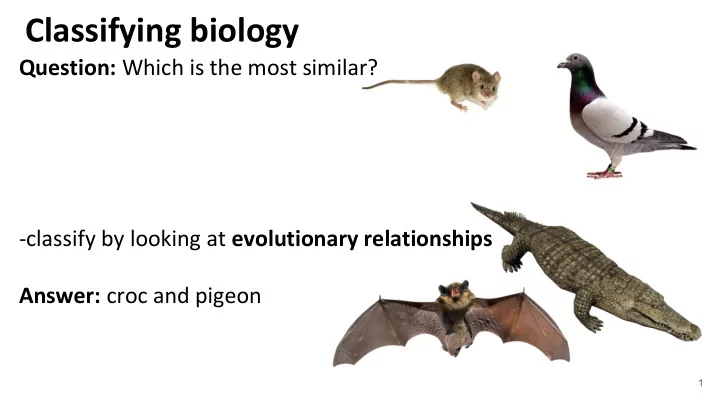

Classifying biology Question: Which is the most similar? -classify by looking at evolutionary relationships Answer: croc and pigeon 1
Macroevolution Classification: categorize organisms to understand evolutionary relationships Kingdom: Animalia Phyla: Chordata Class: Mammalia Order: Primate Family: Hominidae Genus: Homo Species: sapiens 2
Homologies Homologous traits: similarities due to common descent E.g., birds, bats, mice, crocs all have four limbs Contrast with analogies : similarities due to common function 3
Classifying biology Homologies: similarities based on a common ancestor vs Analogies: similarities due to common function 4
Two types of homologies Ancestral traits: similarities in many taxonomic groups inherited from a remote ancestor Derived traits: have been modified from the ancestral conditions 5
Homologies some more 6
Schools of classification Evolutionary systematics: hypothesizes about ancestor-descendant relationships over time -use phylogenetic trees 7
Schools of classification Cladistics: use shared derived traits to identify new species Clades: lineages sharing a common ancestor -Anthropologists mostly use cladistics 8
Compare and contrast classification Evolutionary Systematics: explains ancestor-descendant systems relationships over time Cladistics: uses shared derived traits to classify new species -no time 9
Generalized vs specialized traits Generalized traits adapted for many functions Specialized traits arise during adaptive radiation -generalists specialize to niches 10
Macroevolutionary processes Adaptive radiation: rapid expansion and diversification of groups into empty ecological niches Niche: a species place in an environmental setting 11
Species concepts Biological species concept: groups of interbreeding individuals that are reproductively isolated Speciation occurs if - geographic , behavioral, anatomical isolation -natural selection is acting on populations -highly differential niches 12
Species concepts Paleospecies: groups of fossil organisms that are assigned to the same species. Variation over time needs to be considered when classifying paleospecies Intraspecific: variation within species Interspecific: variation between species 13
Fossils: remains of organisms preserved over time 14
Fossils: remains of organisms preserved over time *Mineralization: organic material chemically turned into rock 15
Fossils: remains of organisms preserved over time *Mineralization: organic material chemically turned into rock *Organisms are trapped in tree resin/an anoxic environment 16
Fossils: remains of organisms preserved over time *Mineralization: organic material chemically turned into rock *Organisms are trapped in tree resin/an anoxic environment *Imprints of tracks or leaves in hardened mud 17
Video question Attendance: Write your name on a piece of paper and respond to the following question: Identify at least three examples of the different concepts discussed in the course so far. E.g., Homologies, mitosis, meiosis, natural selection, selective pressures, genetic drift, gene flow (migration), mutation, etc. https://youtu.be/StqZI9pMq0U 18
Paleozoic era (570-225 mya) -first vertebrates emerged -first mammal-like reptiles -Pangaea formed Mesozoic era (225-65 mya) -Age of dinosaurs Cenozoic era (65-0 mya) -Age of mammals 19
Continental drift: movement of continents on Earth's surface -causes mountain building, volcanic activity, earthquakes, etc Late Paleozoic to Late Mesozoic -plate tectonics caused reproductive isolation 20
Mesozoic to Cenozoic Late Mesozoic era: Age of Dinosaurs -earliest mammals 21
Cenozoic era: age of the mammals 22
Mesozoic to Cenozoic Late Mesozoic era: Age of Dinosaurs -earliest mammals Cenozoic era: age of the mammals 23
Three modern mammalian subgroups Monotremes: most ancestral mammals, e.g., they lay eggs 24
Three modern mammalian subgroups Marsupials: immature birth; development continued in pouch 25
Three modern mammalian subgroups Placental: in utero development 26
Paleozoic era (570-225 mya) -first vertebrates emerged -first mammal-like reptiles -Pangaea formed Mesozoic era (225-65 mya) -Age of dinosaurs Cenozoic era (65-0 mya) -Age of mammals 27
Mammalian shared derived homologies -Endothermic -Heterodont dentition -Placental -Complex brains and f lexible behavior 28
Recommend
More recommend